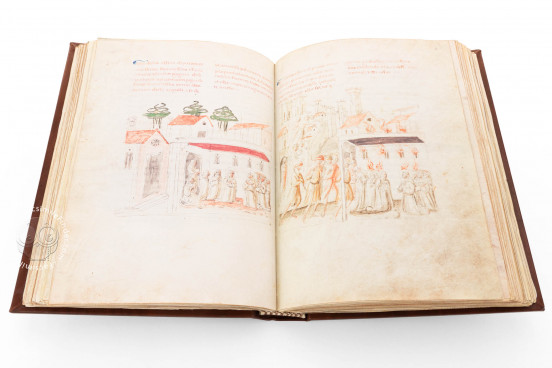The Life and Writings of Saint Francis of Assisi was produced in Foligno, near Assisi, in 1427. It comprises the life and legend of the saint, illustrated with thirty-nine large or full-page miniatures. Most are drawings in ink, while some are sparsely colored in watercolor. This compendium of Franciscan writings in Italian also includes excerpts from Francis's work known as I Fioretti, his testament, and the Franciscan Rule. It also comprises the lives of some of the founding saint's companions and writings on the Stigmata by Thomas of Celano.
Today the manuscript of the Life and Writings of Saint Francis of Assisi is treasured in the Biblioteca Medicea Laureanziana in Florence. This volume, written on parchment, is a remarkable compendium of Franciscan documents dating to the thirteenth century, originally written in Latin and translated into the vernacular in the following century. The book includes a Legend and a Life of St. Francis, excerpts from St. Francis' body of work called I Fioretti, St. Francis' testament, and the rule of the Franciscan order.
The codex also features the lives of three of Francis' main companions, Friar Ginepro, Egidio, and Leone, together with two works by Tommaso da Celano, namely the Considerations on the Stigmata and the Treatise on St. Francis' Miracles.
A Manuscript for Franciscan Use
The manuscript Gaddi 112 is an important witness to the vivid and intense evangelic experience of St. Francis and his first disciples. The book was probably made for the Franciscan environment and kept among the Franciscans.
A note of possession on fol. 170 states that the manuscript was completed on December 29, 1427 and belonged to the Franciscan Tertiary Sisters of Foligno. The manuscript then passed on to the Biblioteca Gaddi and, in 1755, to the Biblioteca Magliabecchiana. In 1783, the book was acquired by the Biblioteca Laurenziana.
Delicate Watercolor Paintings
The manuscript’s decorative apparatus features 39 miniatures, either half-page or full-page, depicted with the watercolor technique, which, in medieval times, was considered a poor technique compared to the more resistant and colorful tempera. The decision to use watercolors might reflect the Franciscan cultivation of poverty, one of the main principles of Francis’ spirituality and teachings.
The miniatures, once attributed to the Florentine workshop of Bicci di Lorenzo, are more probably to be related to the Umbrian environment close to the monastery of Sant'Onofrio and to the Franciscan Tertiary Sisters of Foligno, former owners of the book.
The whole manuscript, its text and images express a profound Franciscan spirituality. The relevance of the manuscript for the Franciscans suggests that the scribe and the illuminator could have been friars of the Franciscan order.
We have 1 facsimile edition of the manuscript "Life and Writings of Saint Francis of Assisi": San Francesco d'Assisi, la vita e le opere facsimile edition, published by ArtCodex, 2010
Request Info / Price



























